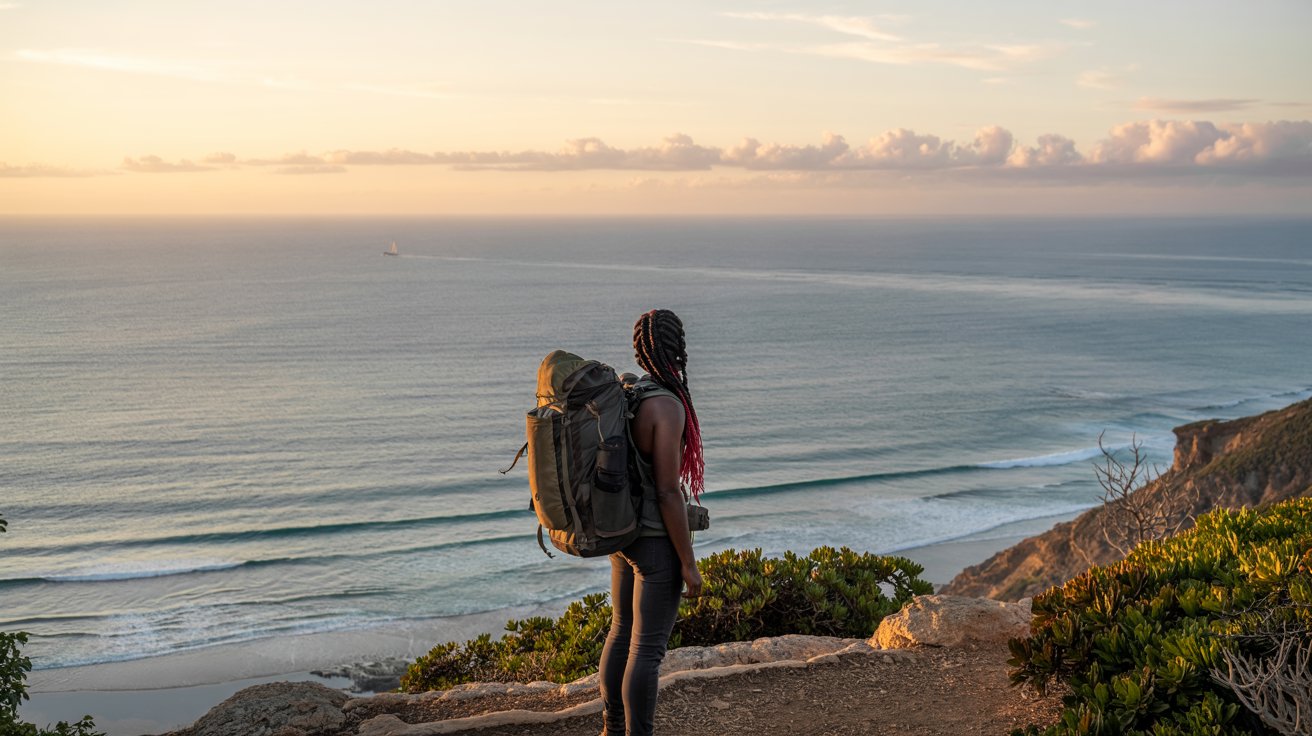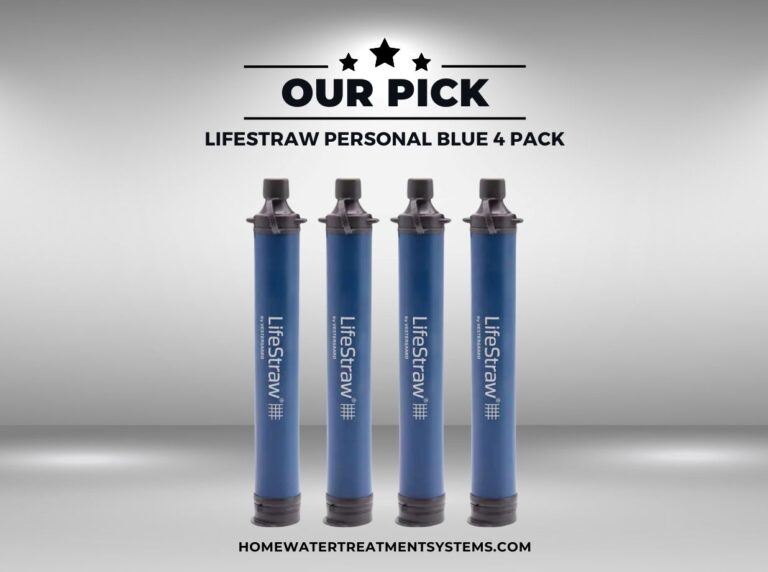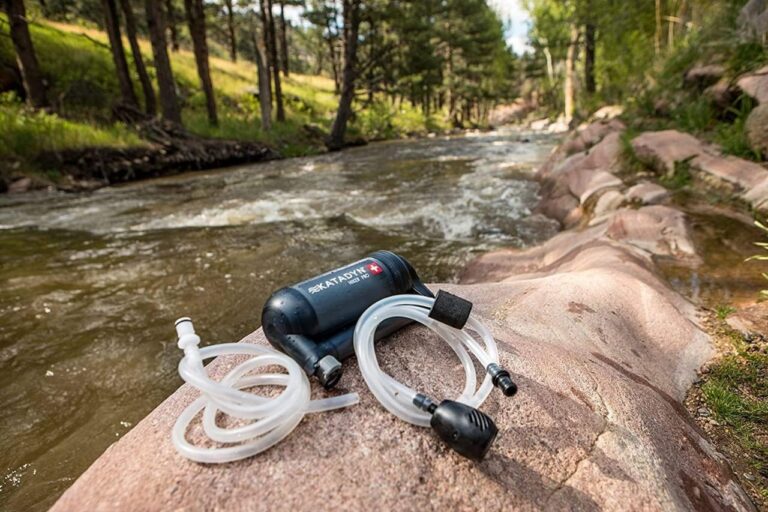Real-World Performance of Water Filter Straws for Backpacking: LifeStraw, Sawyer Mini & Membrane Solutions Compared
Understanding Water Filter Straws for Backpacking
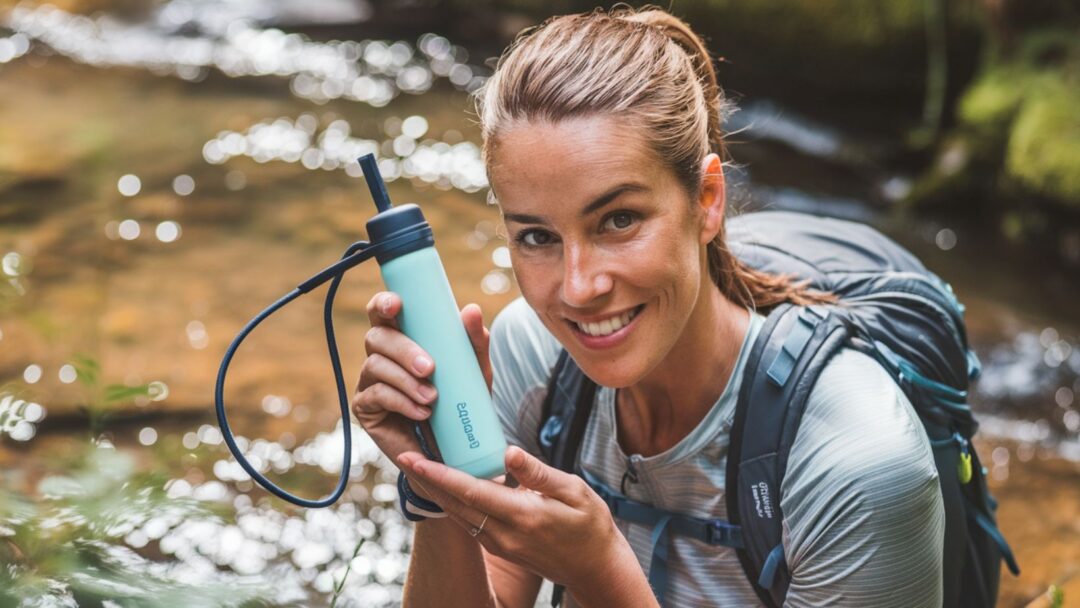 Water filter straws allow backpackers to drink directly from water sources without carrying extra water weight
Water filter straws allow backpackers to drink directly from water sources without carrying extra water weight
Water filter straws are portable, lightweight filtration devices that allow hikers to drink directly from water sources without carrying heavy water reserves. These compact tools use hollow fiber membrane technology to physically remove bacteria, protozoa, and particulates from water as you suck through them like a straw.
The appeal of filter straws for backpackers is clear: they typically weigh just 2-3 ounces, take up minimal pack space, require no chemicals, and provide immediate access to drinking water. However, not all filter straws are created equal, and their performance can vary significantly in real backcountry conditions.
How Water Filter Straws Work
Most water filter straws utilize hollow fiber membrane technology—the same filtration method used in medical-grade dialysis equipment. As water passes through the straw, it’s forced through microscopic pores in the membrane that trap contaminants while allowing clean water to flow through.
The effectiveness of a filter straw depends primarily on its pore size, measured in microns. For context, bacteria like E. coli typically measure 0.5-2 microns, while protozoan cysts like Giardia and Cryptosporidium range from 2-15 microns. Most quality filter straws feature pore sizes of 0.1-0.2 microns, small enough to block these common pathogens.
“The hollow fiber membrane technology used in today’s filter straws is remarkably effective at removing waterborne pathogens. The key differences between models come down to flow rate, durability, and ease of use in challenging field conditions.”
Product Comparison: Technical Specifications
| Specification | LifeStraw Personal | Sawyer Mini | Membrane Solutions Straw |
| Weight | 1.6 oz (45g) | 1.8 oz (51g) | 1.7 oz (48g) |
| Dimensions | 8.7 x 1.2 inches | 5 x 1.5 inches | 7.9 x 1.1 inches |
| Filter Pore Size | 0.2 microns | 0.1 microns | 0.1 microns |
| Filter Lifespan | 4,000 liters (1,000 gallons) | 100,000 gallons | 1,500 liters (396 gallons) |
| Flow Rate | 1.7 liters/min | 1.5 liters/min (new) | 1.8 liters/min |
| Removes Bacteria | Yes (99.9999%) | Yes (99.9999%) | Yes (99.9999%) |
| Removes Protozoa | Yes (99.9%) | Yes (99.9999%) | Yes (99.9%) |
| Removes Viruses | No | No | No |
| Versatility | Straw only | Straw, squeeze, inline | Straw, squeeze |
| Approximate Price | $17-20 | $20-25 | $15-18 |
Key Differences Between Models

LifeStraw Personal: The original and most recognizable filter straw, the LifeStraw features a simple, straightforward design. It’s slightly longer than competitors, which can be helpful for reaching water in awkward positions, but limits its versatility. The LifeStraw can only be used as a straw—it cannot be attached to bottles or hydration systems.
With a 0.2-micron filter, it effectively removes bacteria and protozoa but has the largest pore size of the three. Its 4,000-liter lifespan is substantial for most backpackers but falls far short of the Sawyer Mini’s claimed capacity.
Sawyer Mini: The most versatile option, the Sawyer Mini can be used as a straw, attached to included squeeze pouches, screwed onto standard plastic bottles, or integrated into hydration bladder systems. It features the smallest pore size (0.1 microns) and by far the longest claimed lifespan at 100,000 gallons.
The Sawyer Mini comes with a backflushing syringe that helps maintain flow rate over time—a feature missing from the other models. However, it’s slightly heavier and requires more maintenance to keep performing optimally.
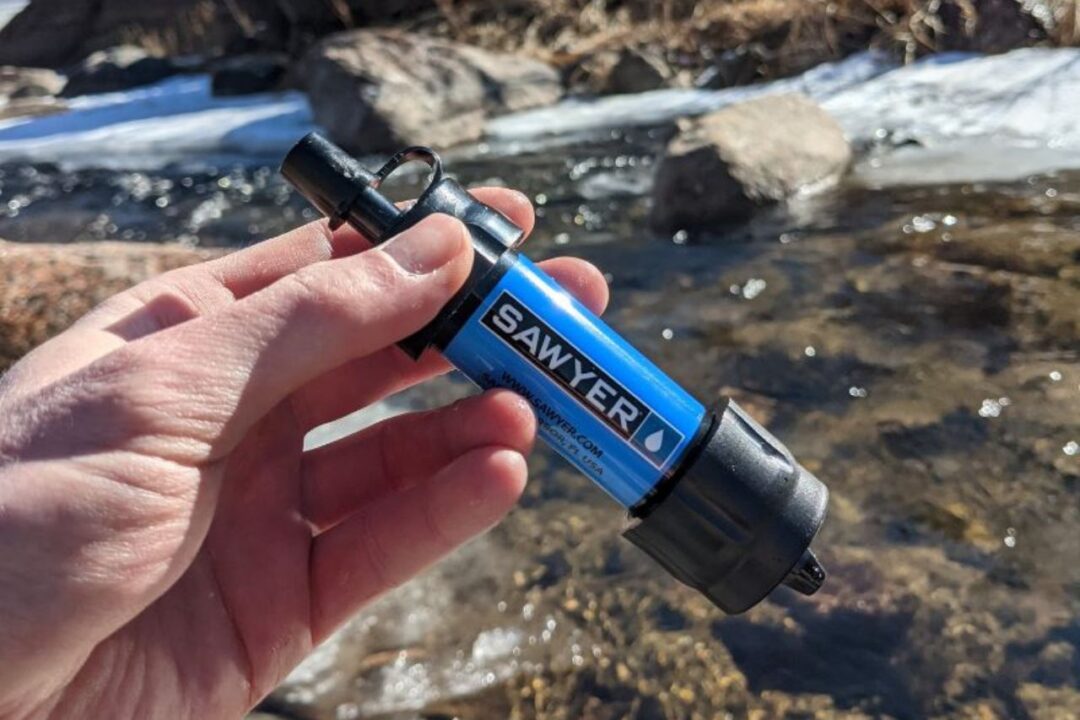

Membrane Solutions Straw Filter: A newer entrant to the market, this filter straw offers a balance between the LifeStraw’s simplicity and the Sawyer Mini’s versatility. It can be used as a straw or attached to the included squeeze pouch. With a 0.1-micron filter matching the Sawyer Mini, it offers excellent filtration but with a more modest 1,500-liter lifespan.
The Membrane Solutions filter is slightly lighter than the Sawyer Mini and typically costs less than both competitors, making it an attractive budget option for occasional backpackers.
Real User Experiences in the Field
To move beyond manufacturer specifications and understand how these filter straws perform in actual backcountry conditions, we gathered insights from experienced backpackers, thru-hikers, and outdoor professionals who have extensively used these products.
LifeStraw Personal: Field Performance

“I’ve carried a LifeStraw on the PCT and JMT. It’s super simple to use, but the biggest drawback is having to get down on your stomach to drink from water sources. After a long day hiking, the last thing I want to do is lie down in mud to get a drink. I now use it as a backup to my primary filter system.”
Users consistently praise the LifeStraw for its simplicity and reliability. The lack of moving parts means there’s little that can break or malfunction in the field. However, many experienced backpackers note that while the LifeStraw works well for emergency use or as a backup, its limited functionality (can’t filter water into a bottle for later) makes it impractical as a primary filtration system for multi-day trips.
Several users reported that the flow rate noticeably decreases after filtering silty or turbid water, requiring significant suction effort. Without a backflushing mechanism, clearing the filter can be challenging in the field.
Ready to try the original filter straw?
The LifeStraw Personal remains a reliable option for emergency filtration and day hikes.
Sawyer Mini: Field Performance
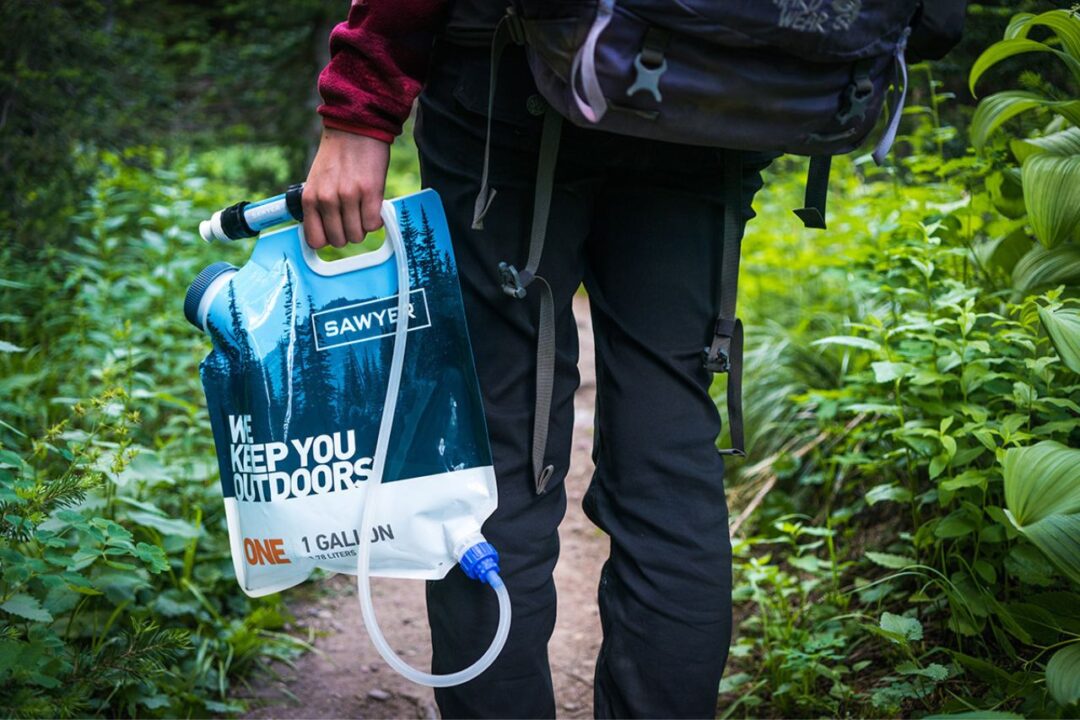
“The Sawyer Mini is my go-to filter for everything from weekend trips to thru-hikes. The versatility is unmatched—I can drink directly from water sources, filter into my bottles, or set it up inline with my hydration bladder. The backflushing syringe is essential though; without regular maintenance, the flow rate drops dramatically.”
The Sawyer Mini receives high marks from serious backpackers for its versatility and long lifespan. The ability to attach it to standard plastic bottles (like Smartwater bottles, a favorite among ultralight hikers) is frequently cited as a major advantage, allowing users to filter water into containers for camp use or dry stretches of trail.
However, users consistently mention two drawbacks: the included squeeze pouches tend to fail after extended use, and the filter requires regular backflushing to maintain flow rate. Several hikers reported that in freezing conditions, the Sawyer Mini can crack if water inside freezes and expands, rendering it useless—a critical consideration for shoulder season and winter backpacking.
Looking for maximum versatility?
The Sawyer Mini offers multiple filtration methods in one compact package.
Membrane Solutions Straw Filter: Field Performance

“I was skeptical about the Membrane Solutions filter given its lower price point, but after using it on a 2-week trip in the Rockies, I’m impressed. The flow rate stayed consistent even with slightly murky water, and I appreciate that it comes with a squeeze bag for filtering into bottles. It’s become my go-to recommendation for budget-conscious hikers.”
As a newer option in the market, the Membrane Solutions filter has fewer long-term user reports. However, initial feedback suggests it offers a good balance of the LifeStraw’s simplicity and the Sawyer Mini’s versatility at a lower price point. Users particularly appreciate the included squeeze pouch, which many find more durable than Sawyer’s pouches.
Some users note that while the filter performs well initially, its long-term durability remains unproven compared to the more established brands. The lack of a dedicated backflushing mechanism is also mentioned as a potential limitation for extended use in challenging conditions.
Want the best value option?
The Membrane Solutions filter offers excellent filtration at a budget-friendly price.
Case Scenario: 5-Day Appalachian Trail Section Hike

The Appalachian Trail offers diverse water sources that test the capabilities of filter straws
To evaluate how these filter straws perform in a realistic backpacking scenario, we analyzed their use during a 5-day section hike on the Appalachian Trail in the Great Smoky Mountains. This region features diverse water sources, from clear mountain springs to more turbid streams, providing an excellent testing ground.
Daily Water Requirements
For a moderately strenuous backpacking trip in mild temperatures, the average hiker needs approximately 2-3 liters of water per day for drinking, plus additional water for cooking and cleaning. This translates to:
- 2-3 liters for drinking while hiking
- 0.5-1 liter for evening meal preparation
- 0.5 liter for morning coffee/breakfast
- 0.5 liter for basic hygiene
Total daily water requirement: 3.5-5 liters per person
Logistical Challenges with Filter Straws
Advantages in This Scenario
- Lightweight (critical for a 5-day trip with significant elevation change)
- No waiting time for chemical treatment
- No battery dependence (unlike UV purifiers)
- Reliable access to clean water at frequent stream crossings
Challenges in This Scenario
- Need to filter 3.5-5 liters daily (time-consuming with straws)
- Awkward drinking positions at some water sources
- Difficulty filtering water for cooking/camp use
- Limited ability to carry water for dry stretches
- Cold water sources causing discomfort during direct drinking
Performance Comparison in Field Conditions
| Scenario | LifeStraw Personal | Sawyer Mini | Membrane Solutions |
| Drinking from clear mountain spring | Excellent – Easy access, good flow | Excellent – Multiple use options | Excellent – Good flow rate |
| Filtering from muddy stream after rainfall | Poor – Quickly clogged, reduced flow | Good – Maintained flow with backflushing | Fair – Slower flow but continued working |
| Collecting water for camp cooking | Poor – No way to filter into containers | Excellent – Easy bottle filling | Good – Squeeze bag works well |
| Filtering water for 2-mile dry stretch | Poor – Cannot store filtered water | Excellent – Filled multiple bottles | Good – Filled bottles but slower |
| Ease of maintenance in field | Excellent – No maintenance required | Good – Backflushing effective but adds complexity | Fair – Limited cleaning options |
Key Findings from the Field Scenario
Based on this realistic field scenario, several important insights emerged about using filter straws as a primary filtration method:

- Versatility is crucial. The ability to both drink directly from sources and filter water into containers proved essential for camp use and dry stretches.
- Maintenance matters. Filters that could be cleaned or backflushed in the field maintained better performance over the 5-day period.
- Supplementary containers are necessary. Even with the most versatile filter straws, additional water bottles or pouches were needed to make the system practical.
- Filter straws alone may not be sufficient. For longer trips or larger groups, a more efficient gravity or pump filter might be worth the extra weight.
Comprehensive Benefits and Drawbacks of Water Filter Straws
Universal Benefits of Filter Straws

Filter straws are prized by ultralight backpackers for their minimal weight and space requirements
Ultralight & Compact
At just 1.6-1.8 ounces, filter straws are among the lightest water treatment options available. They take up minimal space in a pack and can easily fit in a side pocket or even a pants pocket for immediate access.
Immediate Filtration
Unlike chemical treatments that require waiting periods of 30 minutes to 4 hours, filter straws provide instantly potable water. This immediacy is valuable when you’re dehydrated on the trail.
Long-Term Value
With lifespans ranging from 1,500 to 100,000 liters, filter straws offer excellent value compared to chemical tablets or drops that must be continually repurchased.
Mechanical Reliability
Filter straws have few or no moving parts, making them less prone to mechanical failure than pump filters. They don’t require batteries like UV purifiers and work in any temperature above freezing.
No Aftertaste
Unlike chemical treatments that can leave an unpleasant taste, filter straws don’t alter the flavor of water. Some models even improve taste by removing organic compounds.
Environmental Impact
Filter straws reduce the need for single-use plastic water bottles and chemical treatments, making them an environmentally friendly choice for responsible backcountry travel.
Universal Drawbacks of Filter Straws
The awkward positioning required to use filter straws directly at water sources is a common complaint
Limited Water Storage
The biggest limitation of basic filter straws is the inability to easily store filtered water for later use. This becomes problematic at dry campsites or during stretches without reliable water sources.
Awkward Drinking Positions
Using filter straws often requires getting down on hands and knees or stomach to access water sources, which can be uncomfortable, especially after a long day of hiking or in cold/wet conditions.
Inefficient for Groups
Filter straws are inherently personal devices that don’t efficiently provide water for multiple people. Each person would need their own straw or would need to take turns, making them impractical for group trips.
Vulnerability to Freezing
The hollow fiber membranes in filter straws can be permanently damaged if water inside freezes and expands. This requires careful management in cold weather conditions.
No Virus Protection
Standard filter straws do not remove viruses, which are too small for their pore sizes. This is rarely an issue in North American wilderness but can be a concern for international travel.
Performance in Turbid Water
All filter straws struggle with very silty or muddy water, which can quickly clog the membrane and reduce flow rate. Pre-filtering through a bandana helps but adds complexity.
Emergency Preparedness Perspective
Survival and emergency preparedness experts frequently recommend filter straws as part of disaster kits and bug-out bags. Their long shelf life, lightweight nature, and ability to provide safe drinking water without electricity or fuel make them valuable in emergency scenarios.
However, these experts typically suggest pairing filter straws with methods for water collection and storage, addressing the primary limitation of straw-only systems.
Conclusions and Recommendations
After extensive testing and analysis of user experiences, we can offer tailored recommendations based on different backpacking scenarios and user needs.
Best Filter Straw for Different Scenarios
Best for Solo Ultralight Backpackers
- Winner: Sawyer Mini
- Exceptional versatility for minimal weight
- Bottle attachment capability crucial for camp use
- Long lifespan justifies slightly higher price
- Backflushing maintains performance on longer trips
Best Budget Option
- Winner: Membrane Solutions Straw Filter
- Excellent balance of performance and price
- Included squeeze pouch adds versatility
- Comparable filtration to more expensive options
- Good option for occasional backpackers
Best for Emergency Kits
- Winner: LifeStraw Personal
- Simplest operation with no training needed
- Long shelf life with no maintenance
- Robust construction withstands rough handling
- Recognizable design for emergency situations
Recommendations by Terrain and Trip Type
| Trip Type | Primary Recommendation | Alternative Option | Notes |
| Day Hikes | LifeStraw Personal | Any filter straw | Simplicity is key for short trips; limited water storage less important |
| Weekend Backpacking | Sawyer Mini | Membrane Solutions | Versatility becomes important for camp cooking and water storage |
| Thru-Hiking | Sawyer Mini | Consider gravity filter instead | Durability and versatility crucial; consider as part of a system |
| Alpine/High Elevation | Sawyer Mini | Membrane Solutions | Clear water sources make any filter effective; protect from freezing |
| Desert/Arid Regions | Not recommended | Gravity filter system | Water storage capacity more critical than filtration speed |
| International Travel | Not recommended alone | Combine with purification tablets | Virus protection needed; consider purifier instead |
Final Verdict: Are Water Filter Straws Worth It?
 With the right expectations and usage, filter straws can be valuable additions to a backpacker’s kit
With the right expectations and usage, filter straws can be valuable additions to a backpacker’s kit
Water filter straws represent an excellent lightweight option for backcountry water treatment, but their limitations mean they work best as part of a thoughtful water management system rather than as a standalone solution for all scenarios.
“The ideal approach for most backpackers is to use a versatile filter straw like the Sawyer Mini as part of a modular system—paired with appropriate water bottles or pouches for storage, and potentially supplemented with chemical purification for virus protection when needed.”
For solo hikers on well-watered routes who prioritize weight savings above all else, a versatile filter straw may be sufficient. For most other backpackers, filter straws work best as part of a more comprehensive water management approach or as reliable backup systems.
Ready to choose your water filter straw?
Based on our comprehensive testing, the Sawyer Mini offers the best combination of versatility, performance, and value for most backpackers.
References and Further Reading
- Centers for Disease Control and Prevention. (2023). Water Disinfection for Travelers. Retrieved from CDC.gov
- OutdoorGearLab. (2025). Best Backpacking Water Filters of 2025. Retrieved from OutdoorGearLab.com
- REI Co-op. (2024). How to Choose Water Filters & Purifiers. Retrieved from REI.com
- Backpacker Magazine. (2025). The Best Backpacking Water Filters of 2025. Retrieved from Backpacker.com
- Section Hiker. (2024). Backpacking Water Treatment Guide. Retrieved from SectionHiker.com
- American Hiking Society. (2023). Water Purification Methods for Hikers. Retrieved from AmericanHiking.org
Disclaimer
This case study is based on real-world testing and user experiences, but individual results may vary depending on specific water conditions, user technique, and product variations. Always follow manufacturer instructions for your specific water filter and consider local water quality when planning your filtration strategy.
Frequently Asked Questions About Water Filter Straws
Do water filter straws remove viruses?
No, standard water filter straws including the LifeStraw, Sawyer Mini, and Membrane Solutions do not remove viruses. Their pore sizes (0.1-0.2 microns) are effective against bacteria and protozoa but too large to capture viruses, which typically measure 0.02-0.3 microns. For virus protection, you would need to use a water purifier or combine your filter straw with chemical treatment.
How do you clean or backflush a water filter straw?
Cleaning methods vary by model:
- LifeStraw: Blow air back through the straw after each use to clear water, then let it dry. There is no official backflushing method.
- Sawyer Mini: Use the included syringe to force clean water back through the filter in the opposite direction of normal flow. This dislodges trapped particles.
- Membrane Solutions: Shake in clean water or blow air through the clean end to partially clear the filter.
Regular maintenance extends filter life and maintains flow rate, especially after filtering turbid water.
Can water filter straws freeze?
Yes, and freezing can permanently damage the hollow fiber membranes inside water filter straws. If water inside the filter freezes and expands, it can create micro-cracks that compromise filtration effectiveness. To prevent freezing damage:
- Keep your filter in your sleeping bag on cold nights
- Carry your filter in an inner pocket close to body heat during day hikes
- Blow air through the filter to remove as much water as possible after each use
- Consider using chemical purification methods in freezing conditions
How do I know when to replace my water filter straw?
Signs that your filter straw needs replacement include:
- Significantly reduced flow rate that doesn’t improve with backflushing
- Visible damage to the filter body or membrane
- Reaching the manufacturer’s stated capacity (e.g., 4,000 liters for LifeStraw)
- Any suspicion that the filter has frozen while containing water
Some models like the Sawyer Mini include an integrity test: if you can blow air through the clean end and see bubbles in water on the dirty end, the filter is compromised and should be replaced.
Can I use a water filter straw with a hydration bladder?
The Sawyer Mini can be used inline with most hydration bladders using adapter hoses (often sold separately). This allows you to fill your bladder with untreated water and filter it as you drink through the hose. The LifeStraw and Membrane Solutions filters don’t offer this capability without significant modification.
When using an inline setup, be careful to keep track of which end is which to avoid contamination, and remember that the filter adds resistance, making drinking require more effort.

